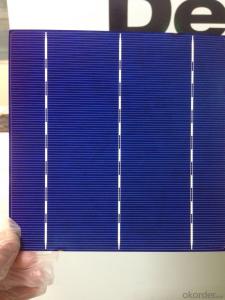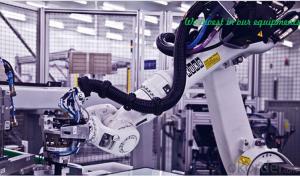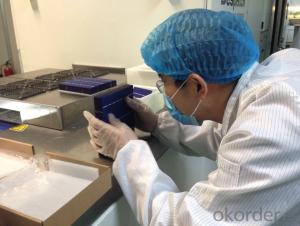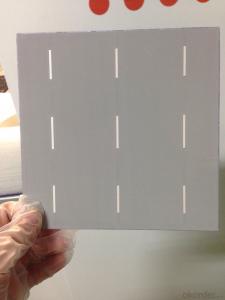Low Efficiency And Low Power Solar Cells 3BB 17.2%
- Loading Port:
- Shanghai
- Payment Terms:
- TT OR LC
- Min Order Qty:
- 20000 pc
- Supply Capability:
- 2000000 pc/month
OKorder Service Pledge
OKorder Financial Service
You Might Also Like
Item specifice
Advantages of Poly Solar Cells
1. High efficiency and High power.
2. Long-term electrical stability.
3. Lowest price and Fastest delivery.
4. Good quality and good service.
5. Bulk supply
6. Good Warranty
7. Big Sale
8. More than 25 years on the lifetime.
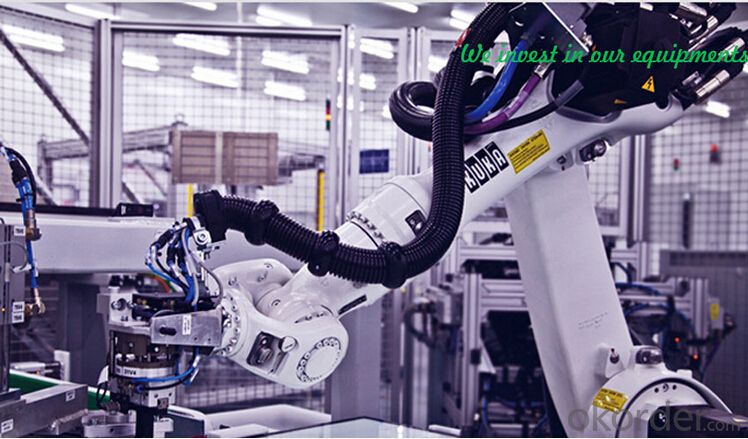

Temperature Coefficient of Monocrystalline Cells
Voc.Temp .coef.%/K:-0.351%/K
Isc.Temp .coef.%/K : +0.035%/K
Pm.Temp. coef.%/K: -0.47%/K
Visual Quality
CNBM Solar sorts cells into four blue color classes and clearly labels them on packaging and shipping documents.
Color uniformity within cells are closely monitored and controlled.
Gives modules a high quality look and feel.
CNBM Solar sets high visual quality standards, screening more than 25 visual criteria.
Performance in High Temperature
CNBM Solar cells produce optimal power output even in high temperature conditions.
Temperature coefficients average 0.1% per °C lower than the competition. This means 3% less power degradation when cell surface temperature increases from 25°C to 55°C.
Performance in Low Light
CNBM Solar Cells perform exceptionally well even in low light.
CNBM Solar A-grade and B-grade cells are screened for shunt resistance.
Higher shunt resistance can result in up to 10% higher annual energy yield for PV systems.
Low Reverse Current
CNBM Solar cells feature low reverse current at both -10V or -12V.
Reduces hot spot risk for long-term reliability.
Environmental Compliance
CNBM Solar cells are developed with environmental protection in mind.
All cells are RoHS compliant.
REACH-SVHC compliance ensures safe entry into the European market.
RoHS compliance: safe limits of Pb and no Cd found.
Usage and Applications of Polycrystalline Cells
Solar cells are often electrically connected and encapsulated as a module. Photovoltaic modules often have a sheet of glass on the front (sun up) side, allowing light to pass while protecting the semiconductor wafers from abrasion and impact due to wind-driven debris, rain, hail, etc. Our Cells can greatly improve the performance of Solar Modules.
Packaging & Delivery of Polycrystalline Cells
Carton Box Package and Deliver by air. It should be noticed that it should be avoid water, sunshine and moist.
FAQ:WHAT'S THE ADVANTAGES OF CNBM?
1.CNBM is a state-owned company under jurisdiction of central goverment , one of Fortune 500 .Just because of this ,we can get more support and resources from our government.So ,it is realiable .
2.CNBM's solar products are high-qualified with TUV,UL,VDE,CE,ISO certificates. Our products ranges top in China.
3.Just as I mentioned in attahment ,we signed 500MW project with Urkan under the witness of our chairman Xi Jinping ,CNBM has ability to meet your large quantity needs,Our annual capacity is 1GW.
FAQ: How many kinds of solar cells can we produce?
•: We can supply the normal 2 kinds of solar cells, Poly 156mm*156mm and Mono125mm*125mm , and the special demension also can be produced .
FAQ:What's the effeciency range of the solar cells?
•: We can supply 16.8% to 18.9% effeciency of the solar cells.
Cell-To-Module Performance (CTM)
1.CNBM Solar improves cell-to-module ratio by:
2.Narrowing down efficiency bin range to 0.2%.
3.Defining efficiency bins by minimal power and 97% of current at maximum power.
4.Customers can manage and control module power output distribution.
5.Customers get more value for their money.
6.Long-Term Reliability
7.High Shunt Resistance
8.Low LID (Light-Induced Degradation)
9.Frequent internal monitoring of LID.
- Q:Can solar cells be installed on vehicles?
- Yes, solar cells can be installed on vehicles. In fact, solar panels are increasingly being used to power various components of vehicles, such as electric cars, hybrid cars, and even boats. These solar cells harness sunlight and convert it into electricity to charge the vehicle's batteries, reducing the reliance on traditional fuel sources and making them more environmentally friendly.
- Q:What are thin-film solar cells?
- Thin-film solar cells are a type of solar cell that utilize thin layers of semiconducting materials to convert sunlight into electricity. These cells are made by depositing thin films of photovoltaic materials onto a substrate, which allows for more flexible and lightweight solar panels compared to traditional silicon-based ones.
- Q:Can the solar powered cells really work better than the normal cells?
- Yes, of course, the solar powered cells are much better than the normal cells, not only it functions better but also because it can save much more ebergy while proving more energy.
- Q:What are the applications of solar cells?
- other areas include: - with the car: solar car / electric car, battery charging equipment, car air conditioning, ventilation fans, cold boxes and so on. Regenerative power generation system for solar hydrogen fueled fuel cell. - desalination equipment supply. - satellite, spacecraft, space solar power station.
- Q:What is the role of solar cells in powering remote monitoring systems?
- Solar cells play a crucial role in powering remote monitoring systems by converting sunlight into electricity. These systems are often installed in remote locations where access to traditional power sources is limited or non-existent. Solar cells provide a sustainable and reliable source of energy to continuously power these systems, allowing for continuous monitoring and data collection even in remote areas.
- Q:What is the impact of leaf litter on solar cell performance?
- Leaf litter can have a negative impact on solar cell performance as it can block sunlight from reaching the surface of the cells, reducing their efficiency and overall power output. Additionally, the buildup of leaf litter can also lead to overheating and potential damage to the solar panels. Regular cleaning and maintenance of solar panels are crucial to ensure optimal performance and maximize energy generation.
- Q:How do solar cells impact the local economy?
- Solar cells can have a positive impact on the local economy in several ways. Firstly, the installation and maintenance of solar panels create job opportunities, stimulating employment and income growth within the community. Additionally, solar energy reduces the reliance on imported fossil fuels, leading to reduced energy costs for local businesses and residents. This, in turn, frees up funds that can be reinvested in the local economy, fostering economic development. Moreover, solar power can also generate revenue for local governments through tax incentives and property value increases. Overall, solar cells contribute to a more sustainable and prosperous local economy.
- Q:What is the impact of temperature fluctuations on solar cell efficiency?
- Temperature fluctuations can have a significant impact on solar cell efficiency. Generally, as temperatures rise, the efficiency of solar cells decreases. This is because higher temperatures can increase the resistance of the materials used in the solar cell, resulting in a decrease in the conversion of sunlight into electricity. Additionally, excessive heat can cause thermal stress and degradation of the solar cell's components, further reducing its efficiency over time. Therefore, temperature regulation and cooling mechanisms are crucial in maintaining optimal solar cell performance and maximizing energy production.
- Q:Can solar cells be used in off-grid systems?
- Yes, solar cells can definitely be used in off-grid systems. In fact, they are one of the most common and efficient sources of renewable energy for off-grid applications. Solar cells, also known as photovoltaic cells, generate electricity from sunlight and can be used to power various devices and systems in remote areas where there is no access to the electric grid. They are reliable, environmentally friendly, and can provide a sustainable energy solution for off-grid living or remote locations.
- Q:Can solar cells be installed on any type of roof?
- Yes, solar cells can be installed on any type of roof, including flat, sloped, metal, tile, and asphalt roofs. However, the suitability and feasibility of installation may vary depending on factors such as roof orientation, shading, structural integrity, and local regulations. It is recommended to consult with a professional solar installer to determine the best options for your specific roof type.
1. Manufacturer Overview |
|
|---|---|
| Location | |
| Year Established | |
| Annual Output Value | |
| Main Markets | |
| Company Certifications | |
2. Manufacturer Certificates |
|
|---|---|
| a) Certification Name | |
| Range | |
| Reference | |
| Validity Period | |
3. Manufacturer Capability |
|
|---|---|
| a)Trade Capacity | |
| Nearest Port | |
| Export Percentage | |
| No.of Employees in Trade Department | |
| Language Spoken: | |
| b)Factory Information | |
| Factory Size: | |
| No. of Production Lines | |
| Contract Manufacturing | |
| Product Price Range | |
Send your message to us
Low Efficiency And Low Power Solar Cells 3BB 17.2%
- Loading Port:
- Shanghai
- Payment Terms:
- TT OR LC
- Min Order Qty:
- 20000 pc
- Supply Capability:
- 2000000 pc/month
OKorder Service Pledge
OKorder Financial Service
Similar products
New products
Hot products
Related keywords
